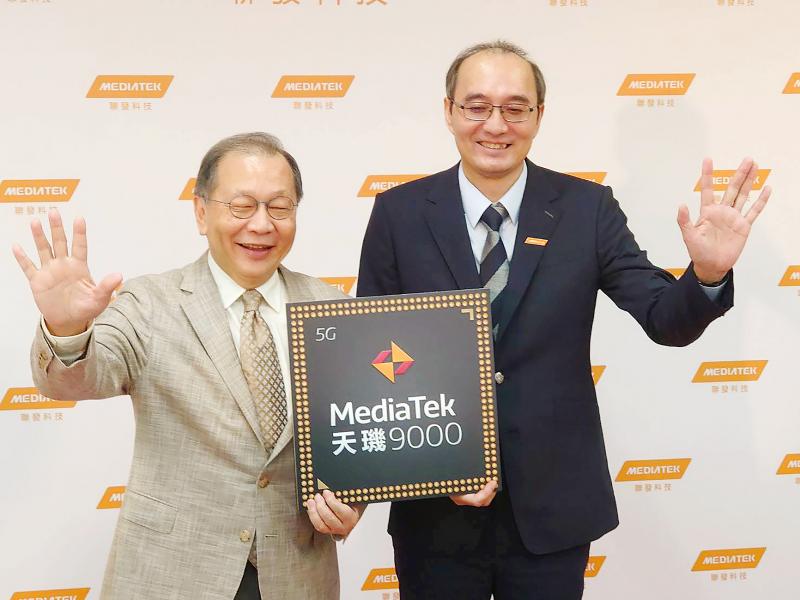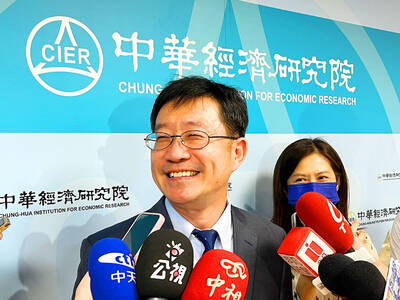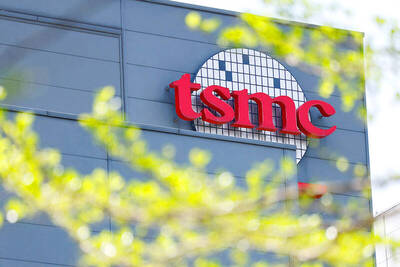MediaTek Inc (聯發科), the world’s largest 5G smartphone chip supplier, yesterday said it expects revenue to grow about 15 percent each year for the next three years, buoyed by its swift technology migrations and expansions in addressable markets.
The Hsinchu-based chipmaker’s strong projection came after reporting 53.2 percent annual revenue growth last year to a record NT$493.4 billion (US$17.73 billion), a step closer to its target of US$20 billion revenue.
MediaTek attributed the strong growth to its early sub-6 gigahertz 5G readiness, and its support of WiFi 6 technologies, helping it capture business opportunities as new products were introduced.

Photo: CNA
The chipmaker seized a 35 percent share of North America’s 5G Android phone chip market last year.
With rising 5G penetration rates and the proliferation of smart edge devices worldwide, MediaTek expects its markets to increase to US$140 billion in 2024, CEO Rick Tsai (蔡力行) told an investors’ teleconference yesterday.
“We believe we will enjoy a revenue compound annual growth rate of about 14 to 16 percent for the next three years with all business groups growing robustly,” Tsai said.
To concentrate its research-and-development resources on promising products, MediaTek streamlined its businesses and separated each into three groups: mobile phones, smart edge platforms and power management chips.
Mobile phone chips were MediaTek’s largest revenue generator last year, accounting for more than 50 percent of its business.
Revenue is to expand this year at a faster pace of 20 percent annually, fueled by growth across the board, 5G chips in particular.
MediaTek aims to double its 5G smartphone chip shipments from regions outside China, including North America, Europe, India and emerging countries, Tsai said.
He said that 5G phones this year are expected to increase to 700 million units worldwide, comprising more than 50 percent of the world’s mobile phones, adding that the penetration rate of 5G phones was close to 40 percent last year.
Gross margin this year is to improve to between 48 percent and 50 percent, from 46.9 percent, on better product portfolios as MediaTek launches flagship 5G chips under its Dimensity brand, along with new-generation WiFi 7 chips.
As the electronics industry enters a slow season, MediaTek expects revenue to rise at a slower rate of 2 percent to 10 percent this quarter, to NT$131.2 billion to NT$141.5 billion. That represents annual growth between 21 percent and 31 percent.
“For the first quarter of this year, we expect revenue from higher 5G adoption and flagship Dimensity 9000 shipments to offset lower seasonal demand for certain consumer products,” Tsai said.
“We also expect a shift toward high-value-added products across all revenue groups, which will benefit gross margin,” he added.
Gross margin this quarter is expected to be between 47.5 percent and 50.5 percent, compared with 49.6 percent last quarter.
Net profit last quarter climbed 6.3 percent quarter-on-quarter to NT$30.15 billion from NT$28.36 billion. On an annual basis, net profits last quarter doubled from NT$14.96 billion in the fourth quarter of 2020.
That brought last year’s net profit to a record NT$111.87 billion, up 170 percent from NT$41.44 billion in 2020. Earnings per share jumped to NT$70.56 last year from NT$26.01 in 2020.
Strong profits and a higher payout ratio of up to 85 percent should allow MediaTek to distribute a cash dividend of NT$72 to NT$76 per share next year. That includes a special cash dividend of NT$16 per share for four years starting this year.

WEAKER ACTIVITY: The sharpest deterioration was seen in the electronics and optical components sector, with the production index falling 13.2 points to 44.5 Taiwan’s manufacturing sector last month contracted for a second consecutive month, with the purchasing managers’ index (PMI) slipping to 48, reflecting ongoing caution over trade uncertainties, the Chung-Hua Institution for Economic Research (CIER, 中華經濟研究院) said yesterday. The decline reflects growing caution among companies amid uncertainty surrounding US tariffs, semiconductor duties and automotive import levies, and it is also likely linked to fading front-loading activity, CIER president Lien Hsien-ming (連賢明) said. “Some clients have started shifting orders to Southeast Asian countries where tariff regimes are already clear,” Lien told a news conference. Firms across the supply chain are also lowering stock levels to mitigate

Six Taiwanese companies, including contract chipmaker Taiwan Semiconductor Manufacturing Co (TSMC, 台積電), made the 2025 Fortune Global 500 list of the world’s largest firms by revenue. In a report published by New York-based Fortune magazine on Tuesday, Hon Hai Precision Industry Co (鴻海精密), also known as Foxconn Technology Group (富士康科技集團), ranked highest among Taiwanese firms, placing 28th with revenue of US$213.69 billion. Up 60 spots from last year, TSMC rose to No. 126 with US$90.16 billion in revenue, followed by Quanta Computer Inc (廣達) at 348th, Pegatron Corp (和碩) at 461st, CPC Corp, Taiwan (台灣中油) at 494th and Wistron Corp (緯創) at

NEGOTIATIONS: Semiconductors play an outsized role in Taiwan’s industrial and economic development and are a major driver of the Taiwan-US trade imbalance With US President Donald Trump threatening to impose tariffs on semiconductors, Taiwan is expected to face a significant challenge, as information and communications technology (ICT) products account for more than 70 percent of its exports to the US, Chung-Hua Institution for Economic Research (CIER, 中華經濟研究院) president Lien Hsien-ming (連賢明) said on Friday. Compared with other countries, semiconductors play a disproportionately large role in Taiwan’s industrial and economic development, Lien said. As the sixth-largest contributor to the US trade deficit, Taiwan recorded a US$73.9 billion trade surplus with the US last year — up from US$47.8 billion in 2023 — driven by strong

ASE Technology Holding Co (ASE, 日月光投控), the world’s biggest chip assembly and testing service provider, yesterday said it would boost equipment capital expenditure by up to 16 percent for this year to cope with strong customer demand for artificial intelligence (AI) applications. Aside from AI, a growing demand for semiconductors used in the automotive and industrial sectors is to drive ASE’s capacity next year, the Kaohsiung-based company said. “We do see the disparity between AI and other general sectors, and that pretty much aligns the scenario in the first half of this year,” ASE chief operating officer Tien Wu (吳田玉) told an